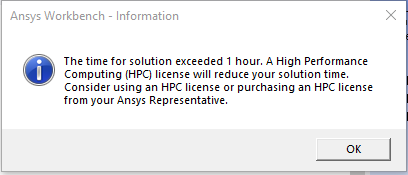TAGGED: #fluent-#ansys, #fsi-#transient, #mechanical-#workbench, 2-way-coupled-fsi, 2-way-fsi, ansys-fluent, ansys-hpc, ansys-mechanical, ANSYS-Transient, fsi-2-way, fsi-simulation, hpc, hpc-cluster, hpc-guide, hpc-licence, hpc-licences, hpc-license, hpc-parallel-licenses, mechanical, transient-structural
-
-
October 3, 2025 at 10:09 pm
andres.baeza
SubscriberHi everyone, I'm running a FSI simulation (Fluent + Transient Structural + Ansys Coupling) that's taking me quite a while to solve (even days). Sometimes, when I run tests in Transient Structural, after the simulations (which take a couple of hours to complete), I get a recommendation to use an HPC license. Is it possible for you to explain in detail what this is about and if I can use it with Ansys Coupling?
-
October 6, 2025 at 6:11 pm
peteroznewman
SubscriberA two-way FSI coupled solution has a Transient Structural analysis and a Transient Fluent analysis linked by a System Coupling block.
Transient Structural uses the MAPDL solver and in a nonlinear model, performs several iterations at each time step to converge before sending an update to Fluent.
The Fluent solver performs several iterations at each time step to converge before sending an update to Structural.
The time taken to compute one iteration depends on the model size, the amount of RAM, the clock speed of the CPU, the number of cores, the speed of the storage media (HDD vs SSD).
With no HPC licenses, the solvers can use a maximum of 4 cores. You can set the solvers to use only 2 cores and observe how long each iteration takes compared with 4 cores.
If you have HPC licenses, you can set the solvers to use 8 cores (if you have them). This does not reduce the time per iteration in half (50%). It reduces the time by a smaller percentage.
The time reduction of using 8 cores instead of 4 cores may be larger in Fluent than in Structural due to the nature of the calculations being performed.
An HPC Pack license allows you to solve using a compute GPU (if you have one). This is separate from the GPU driving the display. The Fluent solver will get more benefit from a compute GPU than the MAPDL structural solver in terms of reducing iteration time.
If you have a high core count computer with sufficient RAM such that the structural model is solving entirely in RAM (incore, not out-of-core), you can request an HPC trial license from your ANSYS distributor and perform some testing on the total compute time of your model with higher number of cores. If the structural model is solving out-of-core, you should first install additional RAM and make sure you have a fast SSD to use while solving.
-
October 7, 2025 at 3:18 am
andres.baeza
SubscriberThanks for your response. If I wanted to know if my university's PCs have HPC licenses (for using more than four cores), how could I find out using that PC and how many licenses it has left?
-
-
October 7, 2025 at 11:17 am
peteroznewman
SubscriberAsk your university's IT department or the Engineering department that acquired the Ansys licenses.
-
October 7, 2025 at 2:13 pm
andres.baeza
SubscriberI am finding out the information. Suppose I request the 30-Day Trial of Ansys HPC, how do I activate it on my Ansys and know how many I have available?
-
-
October 7, 2025 at 4:36 pm
peteroznewman
SubscriberYou don’t activate anything. You need to get whoever setup the Ansys licenses you are now using, either the university IT department of someone in the Engineering department to request the 30-Day Trial of Ansys HPC and they would recieve a new license file to add to the license server and they will let you know what is included in the HPC Trial license and when that is installed.
-
- You must be logged in to reply to this topic.


- Basic questions about HPC license
- optiSLang: general question about output variables & expressions
- Keeping concentration same for different sized particles in discrete phase model
- 3-Way System Coupling (Thermal-Structural-Fluid)
- optiSLang & AEDT Optimetrics: response variable has value of 0
- Thermal Desktop: Running RadCAD and SINDA outside of AutoCAD

-
4522
-
1494
-
1386
-
1209
-
1021

© 2025 Copyright ANSYS, Inc. All rights reserved.








